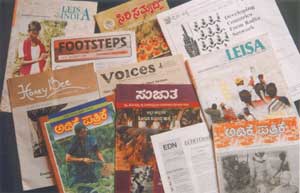Growing more than crops
Dr. Shivaram Pailoor introduces the Centre for Alternative Agricultural Media.

A novel venture in the field of agricultural communication has been initiated in Dharwad, Karnataka. The Centre for Alternative Agricultural Media (CAAM) was established to focus on farmer friendly communication system. The first of its kind in India, CAAM is the desi version of various alternative communication efforts, which are need-based, pro-farmer and involving farmersí participation, that have sprung up all round the world. The alternative agricultural media, which stresses the need for pro-farmer ideologies and practices in agricultural research and communication, is encouraging the farmers' self- respect and self-reliance.
Inaugurating this novel venture in December 2000, renowned farm journalist and campaigner for farmer friendly media Mr. Shree Padre stressed that for most of the problems faced by the agricultural sectors, the farmers themselves have an indigenous solution. But mainstream media does not disseminate or highlight this knowledge. Also, it is unfortunate that those who have experience in farming do not write, and likewise those who write do not have farm experience. Mr. Padre recounted the development of Adike Pathrike, a journal published by a farmersí group trained trained in journalism. Clearly, he said, the information obtained directly from the farmers' experiences is more authentic, and thus more valuable, to their needs that solutions obtained from outside their lives.
 CAAM
CAAMKrishnalaya 1st main, 4th cross, Narayanapur, Dharwad - 580 008 Karnataka www.farmedia.org |
- Development of a need-based communication system for farmers.
- Promotion of alternative efforts in agricultural communication.
- Identification and documentation of similar and related initiatives worldwide.
- Encouragement of self-help journalism among farmers.
- Establishing an information database along several lines, namely.
- a library on alternative agriculture and alternative agricultural communication;
- a website
- an e-bulletin: for effective networking among like-minded individuals/organisations, engaged in innovative alternative efforts in farm journalism sector.
- Promoting communication between farmers and scientists/government.
Farmers trained in journalism and communication are themselves able to record their knowledge of solutions to particular problems. With that achieved, the remaining barrier is to make this knowledge available to other farmers who encounter similar obstacles. There is also fairly good evidence that journals and magazines that serve farming communities are received fairly well. Annadata in Telugu has a circulation of more than 75 thousand, for example. Adike Pathrike and Sujatha in Kannada also have more than 5 thousand subscribers.
Apart from developing farmers' own media, it is equally important that material developed by farmers should appear in mainstream publications, which have a much larger reach. CAAM's focus on training farmers in journalism goes a long way towards making this possible. The online presence of this initiative is fairly small, given the limited access farmers have to the internet, but the information gathered by CAAM is already available; dissemination is certainly helpful to furthering inter-farmer learning. Also, an important use of the media is to make other communities aware of concerns among farmers, and to seek their support when problems arise.
An important difference between rural and urban life, and the very source of the disparities in income-generating activities in the two, is that farm communities do not have established systems by which knowledge is transferred as readily as in the cities. CAAM is an initiative that recognizes this void, and attempts to fill it with practical and meaningful information to improve farmers' lives.
Dr. Shivaram Pailoor
February 2001